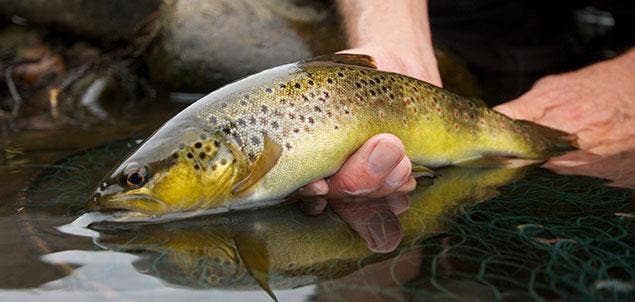Jonny – So Nick, mayflies! We all know about the great hatches which turn trout into zombie-like creatures, gorging themselves at the surface and taking even the most poorly presented fly, but surely there is more to it than that?
THE NYMPH
Nick: You are spot on, Jonny, there is far more to mayflies than meets the eye! They spend their first couple of years on the river bed as a nymph, where they form an important part of a trout’s diet. It’s crucial to be able to mimic this life stage if the fish aren’t rising to anything on the surface. Just make sure the fishery or beat you are fishing allows the use of subsurface patterns.A real classic is the Walker‘s Mayfly Nymph, a pattern that has proven to be a very effective trout-catcher over the years. It’s worth having a few of these in your box, both in the weighted and un-weighed varieties. Do bear in mind though, it’s a popular fly and trout in pressured areas may have seen a fair few before yours, so it’s worth having alternatives.
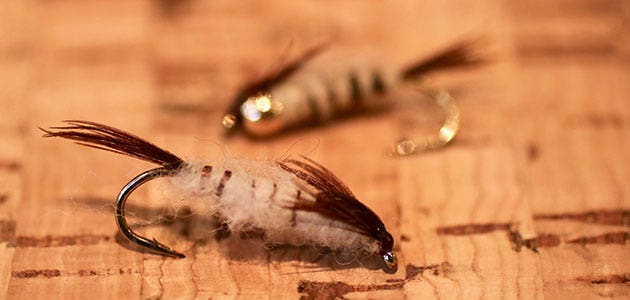 Walker's Mayfly
Walker's MayflyJonny: So how would you go about fishing the mayfly nymph?
Nick: You can fish them upstream dead-drifted but also, if rules allow, try letting them swing a little and impart some long, smooth pulls to bring them to life. You can even fish them New Zealand-style under a big buoyant dry fly. Overall, think induced take, lifting the nymph from the river or lake bed in an enticing fashion several times during the drift.
The mayfly nymph is a silt burrower, so they tend to be most plentiful on systems such as chalk streams rather than rivers with a rocky bottom, but that’s not to say you won’t find them on your local freestone venue. Rivers like the Taw in the west country can experience fantastic mayfly hatches, as can many small stillwaters, reservoirs and lochs. Irish stillwater venues such as Corrib are renowned for their mayfly fishing and if you are in my neck of the woods, try venturing up the Upton Arm on Wimbleball Lake in early June and you might just find a few.
Jonny: Sounds like they can be quite a versatile pattern, and I know companies such as Fulling Mill offer a great version of the Walker‘s Mayfly Nymph, both unweighted and with a goldhead. What advice do you have for fly tyers who might want to whip up a few of their own mayfly nymphs?
Nick: We are so lucky now to have synthetics such as Wapsi Superfine to hand, which offer very realistic colour matching. I like to blend Lt Cahill with Tan, dub on to waxed thread and pick out well to create as much movement as possible. Other materials with great mobility include ostrich herl or dubbed marabou, to impart maximum movement. Have a look around the internet for some of the articulated patterns too, which are really life like and particularly useful when fishing stillwaters for fish feeding on mayfly nymphs. Finally, don’t forget to include the distinctive markings which really make this specie of upwing nymph so distinguishable and easy to identify.
THE EMERGER
Jonny: I’m off to the River Dun in a couple of weeks so I better get tying then! So that’s the nymph stage, what is the next step of the mayfly life cycle that fly fishers can imitate?Nick: Watch the water because it is fascinating to observe as the nymph case splits open and the fly emerges, extending its wings and hoping to dry them as quickly as possible. Mayflies are especially vulnerable during this stage of their lifecycle and trout love sipping them down as they struggle to break free from the surface.
The French Partridge Mayfly is a great generic pattern that can imitate multiple life stages, but I really like to fish it as an emerger. Apply just enough floatant such as Gink by liquifying the gel between your fingers, and aim to present the fly suspended in the surface film, allowing the soft fibres to twitch around naturally in the current as you dead-drift it back downstream - deadly!
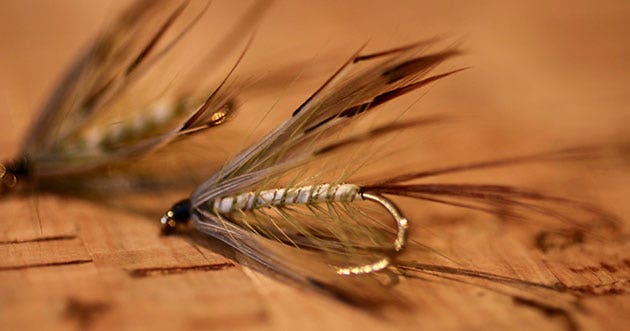 Mayfly French Partridge
Mayfly French PartridgeThe traditional French Partridge has been around for a long time and just looks right, but I also really like the use of knotted legs and shuttlecock style Cul de Canard (CDC) incorporated into the Fulling Mill Crippled Mayfly. CDC fibres keep the front of the fly just above the surface, while the rear of the fly and its legs dangle enticingly down below.
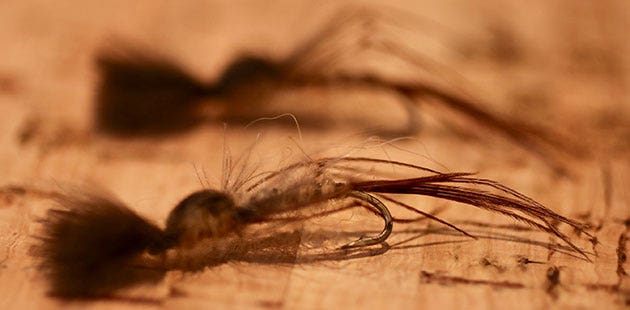 Crippled Mayfly
Crippled MayflyThis is also a brilliant pattern to imitate the stillborn mays that have spent two years below only to become trapped at the surface, resulting in an easy meal which is confidently taken whenever a feeding trout happens upon them. Watch out for this Jonny, because some fish may become selective and pick out the stillborns in which case a full dry fly might well be ignored!
THE DUN PHASE
Jonny: So that’s the nymph and emerger covered, I guess all I need is some of the adult imitations and I am done… right?Nick: Mmmm, not quite! If the mayfly manages to free itself from its case it is known as a dun. Easy to remember because it has ‘done being a nymph!‘ This stage is easily distinguished from the full adult 'mayfly spinner’ by their opaque wings and duller bodies. At this point they’re not ready to mate but need to complete the change by finding somewhere safe to rest while their wings strengthen and dry. Mayflies in the dun stage are often seen throughout the day of a hatch but are particularly visible from early afternoon as the air temperature rises.
Before their wings have dried and strengthened completely, Duns can be clumsy fliers and make a nice meal for a hungry trout (and birds!) as they bumble around on the water. You can often see them lifting off from the surface and rising a few feet, before losing power and dropping back down again. This can turn the trout into hooligans as they slash indiscriminately at the immature mayflies during a large hatch as they struggle to become airborne.
Once again, I turn to CDC when imitating the dun, and always have a Baz’s Mayfly to hand, a pattern that you simply must have in your box! Grey CDC wings add plenty of buoyancy, whilst also mimicking the dun’s opaque wing colour. I really like the body, which is tied along the hook rather than extended, with strong markings to replicate the segmented abdomen offering superb trigger points. Experiment with a little floatant as per my previous advice and get this fly sat right into the surface film, that’s when I feel most confident that it will be taken.
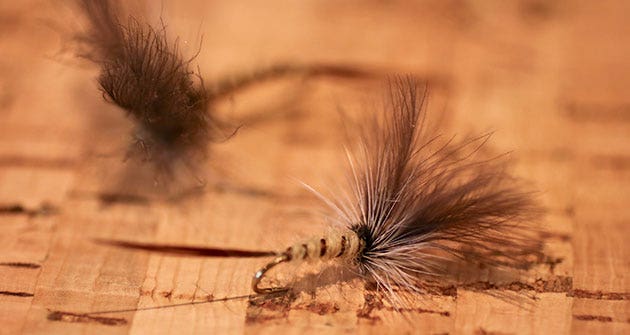 Baz's Mayfly
Baz's MayflyBeware though, trout can become fussy around duns as they are such a large fly, especially patterns such as Oliver Edwards Mohican May which looks incredibly realistic but must be fished naturally. Don’t be tempted to cast straight at a targeted fish, as the fly suddenly appearing could spook it, or at least make it wary.
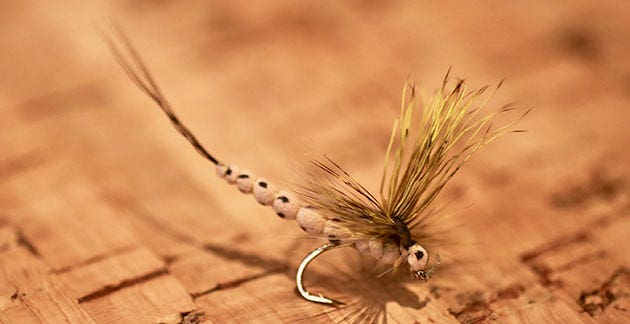 O E Mohican Mayfly
O E Mohican MayflyInstead, give the fish some lead, presenting several feet above the lie, with no drag and be ready for a slow, purposeful take. In most circumstances I am all for a swift strike when dry fly fishing, being used to the speed of trout on west country streams, but when a mayfly feeder takes ensure you lift smoothly, giving the fish time to fully turn down on the fly. With so much food around during a large hatch the trout can become lazy, lift too soon and the chance will be gone.
THE SPINNER BECOMES SPENT
Jonny: I can see that I need to stock up my fly box with more patterns than I had expected! The life cycle and trying to match each stage is a fascinating challenge. Anything else you can tell me that, pardon the pun … MAY help?!Nick: Groans! Hopefully your fishing is better than your jokes Jonny! Yes, there is more. The juvenile fly, having dried its wings and survived being eaten will now transform once again. As the body moults, the wings become clear and the fly becomes ready to mate. This really is a mayfly in all its splendour, dressed for the ball.
An angler who has stayed on the water long enough could be in for one of fly fishing’s great wonders of the world as the adults dance in mesmeric fashion, finally completing their mission to reproduce which would seem as arduous and dangerous as climbing El Capitan without a rope, if not more so.
The males gather together in vast swarms while the females fly amongst them to fertilise their eggs. Duty done, many of the males now fall to the ground, exhausted and without even a last supper to enjoy as they have no working mouth parts with which to feed. I’m glad I am not a mayfly!
Meanwhile, the females have one final important task to complete as they risk the danger of the water once again, dipping to the surface to lay the eggs which will ultimately result in not only the continuation of their genes in years to come but important sustenance for the trout, and one of the most important events in the fly fishers calendar…
Wings outstretched like a miniature aeroplane the females (and some males) are now buried at sea, as they float downstream at the mercy of the current, allowing fish to gorge themselves once more. Choose a fly such as the simple Spent Spinner which has many similarities in tying to the Walkers Mayfly we discussed earlier and if you can possibly get your hands on them, Davy McPhail, the renowned Scottish knitter of deadly flies, has a new pattern available which I can’t wait to tie on soon.
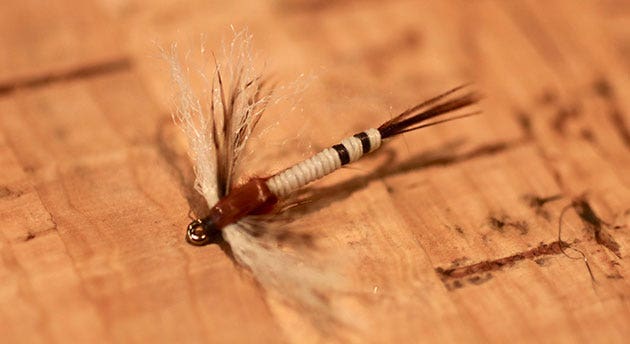 Spent Mayfly
Spent MayflyJonny: “Could you lend me a couple?!”
Nick: “Err, no, sorry Jonny I don’t have any spare!” They should be back in stock soon though so look out for them and, just as per our chat so far, observe the water, see how the naturals are behaving during their final moments of life and try to mimic this with your artificial. A degreased leader, correctly floated fly and ability to make a lifelike presentation will help you catch many more than the duffers who come out to flail the water during this annual bonanza, especially towards the end of the hatch when the fish have seen it all.
Jonny: I just hope we experience a mayfly hatch when I next visit the river! Any final tips?
Nick: Leaders. Knotless tapered are a must to turn over these large flies which have a lot of air resistance and don’t be afraid to up the strength. If you fish too light you risk breaks when the big fish come out to play and soft leader materials are prone to spinning. My go to leader is RO Powerflex in 5lb when fishing for mayfly feeders and I will often extend from 9’ to 12’ using another section of equivalent breaking strain. Even better, go for an 8lb or 6lb point, whichever you feel most appropriate and scale down from there.
Try fluorocarbon such as Froghair too, it sinks of course but the fly will not be on the water for long and it saves degreasing the leader when the fishing is frantic. My favourite knot for joining is the water knot, using 3 to 4 turns and well lubricated with saliva before pulling tight.
It also worth picking up a book to learn more about the mayfly lifecyle and the clear explanations between pages 85 and 91 of Pat O’Reillys ‘Matching the Hatch‘ is excellent. In fact, this book is a brilliant guide to all the hatches applicable to trout on stillwater, river and stream.
2019-05-10 07:36:56
1021 view(s) 

